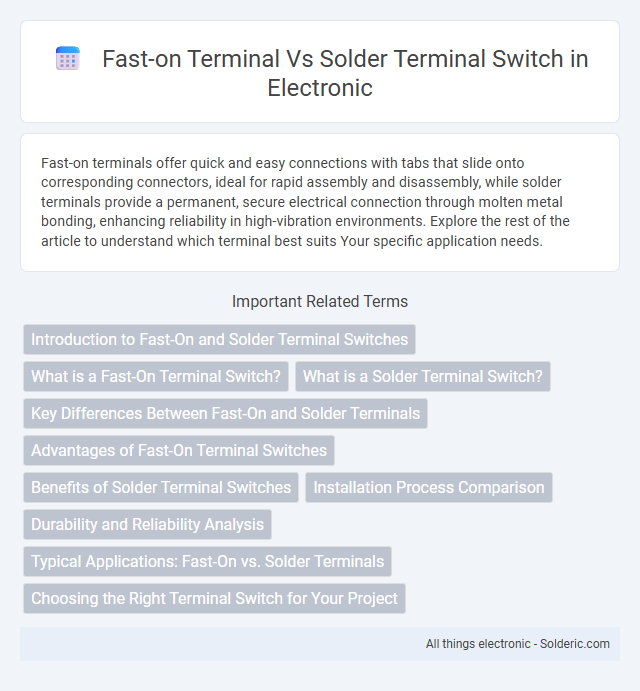Fast-on terminals offer quick and easy connections with tabs that slide onto corresponding connectors, ideal for rapid assembly and disassembly, while solder terminals provide a permanent, secure electrical connection through molten metal bonding, enhancing reliability in high-vibration environments. Explore the rest of the article to understand which terminal best suits Your specific application needs.
Comparison Table
| Feature | Fast-On Terminal Switch | Solder Terminal Switch |
|---|---|---|
| Connection Type | Quick-connect, slide-on terminals | Permanent soldered joints |
| Installation Speed | Fast, tool-less assembly | Slower, requires soldering tools |
| Reliability | Good for quick fixes; may loosen over time | Highly reliable, strong electrical contact |
| Maintenance | Easy to disconnect and replace | Difficult to repair without resoldering |
| Suitability | Ideal for prototyping and frequent changes | Best for permanent, stable connections |
| Cost | Generally lower due to simpler assembly | Higher due to soldering process |
| Electrical Performance | Stable but slightly higher resistance | Lower resistance and better conductivity |
Introduction to Fast-On and Solder Terminal Switches
Fast-On terminal switches feature quick-connect tabs that allow rapid and secure wire attachment without soldering, making them ideal for applications requiring easy disassembly and maintenance. Solder terminal switches provide a permanent connection through soldering, ensuring robust electrical continuity and mechanical stability in circuits subject to vibration or movement. Choosing the appropriate switch depends on your need for either fast installation or long-term reliability in electronic assemblies.
What is a Fast-On Terminal Switch?
A Fast-On terminal switch features flat, blade-like connectors designed for quick and secure attachment without the need for soldering, enhancing ease of installation and maintenance. These terminals provide reliable electrical contact with minimal assembly time, making them ideal for applications requiring frequent disconnection or replacement. Compared to solder terminal switches, Fast-On terminals improve efficiency by eliminating the soldering process while maintaining strong mechanical and electrical connections.
What is a Solder Terminal Switch?
A solder terminal switch features metal tabs designed for direct soldering onto a circuit board, ensuring a secure and reliable electrical connection. This type of terminal provides enhanced durability and resistance to vibration compared to fast-on terminals, making it ideal for permanent installations. Solder terminal switches are commonly used in applications where long-term stability and strong mechanical bonds are essential.
Key Differences Between Fast-On and Solder Terminals
Fast-on terminals provide quick and reliable connections through slide-on tabs, enabling easy disconnection without specialized tools, while solder terminals create permanent, stronger bonds by melting solder to join wires. Fast-on terminals are ideal for applications requiring frequent maintenance or replacement, whereas solder terminals excel in durability and resistance to vibration or environmental factors. Your choice depends on whether convenience or long-term stability is prioritized in the electrical connection.
Advantages of Fast-On Terminal Switches
Fast-on terminal switches offer quick and secure connections, eliminating the need for soldering and reducing assembly time significantly. These terminals provide easy installation and maintenance, ensuring reliable electrical contact with minimal risk of damage from heat during soldering. Their design supports high vibration resistance and improved durability in various industrial and automotive applications.
Benefits of Solder Terminal Switches
Solder terminal switches offer superior electrical conductivity and a more secure, reliable connection compared to fast-on terminals, reducing the risk of loose contacts and electrical failures. These switches provide enhanced durability in high-vibration or high-temperature environments, making them ideal for applications requiring long-term stability. Your projects benefit from the precise and permanent connections solder terminals ensure, improving overall performance and safety.
Installation Process Comparison
Fast-on terminal switches enable quicker installation by allowing components to be connected via pre-attached male and female connectors, eliminating the need for soldering tools and reducing assembly time. Solder terminal switches require a soldering iron and precise heating, which increases the complexity and duration of the installation process but provides a more secure and vibration-resistant connection. Industries valuing rapid assembly often prefer fast-on terminals, while applications demanding long-term durability typically utilize solder terminals.
Durability and Reliability Analysis
Fast-on terminal switches offer superior durability due to their secure, vibration-resistant connections that reduce wear and risk of disconnection over time. Solder terminal switches provide a more permanent and reliable electrical bond, minimizing resistance and potential failure caused by corrosion or mechanical stress. Both types demonstrate high reliability in different applications, with fast-on terminals excelling in maintenance ease and solder terminals excelling in longevity under harsh conditions.
Typical Applications: Fast-On vs. Solder Terminals
Fast-On terminals are commonly used in applications requiring quick, tool-free connection and disconnection such as automotive wiring, household appliances, and industrial machinery. Solder terminals provide a more secure and vibration-resistant connection, making them ideal for electronics, circuit boards, and devices where reliability and durability are critical. Choosing the right terminal ensures Your switch performs optimally according to the specific mechanical and electrical demands of the application.
Choosing the Right Terminal Switch for Your Project
Fast-on terminals offer quick and reliable connections without the need for soldering, making them ideal for projects requiring easy assembly and maintenance. Solder terminals provide a more secure and permanent bond, enhancing electrical conductivity and durability in high-vibration environments. Evaluating your project's demands for assembly speed, reliability, and environmental conditions helps you choose the optimal terminal switch for Your application.
fast-on terminal vs solder terminal switch Infographic

 solderic.com
solderic.com